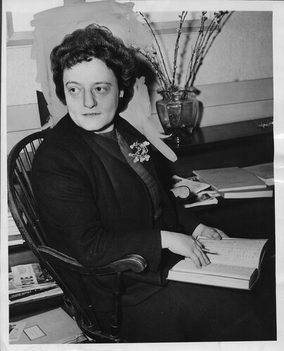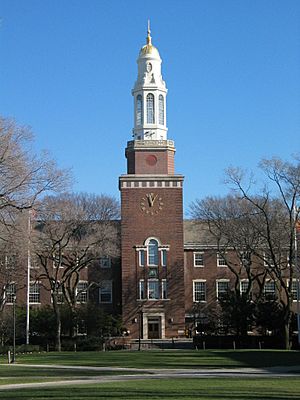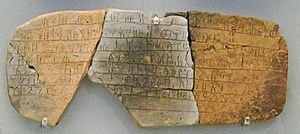Alice Kober facts for kids
Quick facts for kids
Alice Elizabeth Kober
|
|
|---|---|

Alice Kober in 1946
|
|
| Born |
Alice Kober
December 23, 1906 |
| Died | May 16, 1950 (aged 43) Brooklyn, New York City
|
| Alma mater | Hunter College (BA) Columbia University (MA, PhD) |
| Relatives | Franz Kober (Father), Katharina Kober (Mother), William Kober (Brother) |
Alice Elizabeth Kober (born December 23, 1906 – died May 16, 1950) was a brilliant American scholar. She was a "classicist," meaning she studied ancient Greek and Roman cultures. Alice is most famous for her amazing work on Linear B. This was an ancient writing system that no one could understand.
She taught at Brooklyn College for many years. In the 1940s, she published important papers about Linear B. Her discoveries helped show how the script worked. This was a huge step towards finally figuring out what Linear B meant.
Contents
Alice Kober's Early Life and School
Alice Elizabeth Kober was born in New York City. Her parents, Franz and Katharina Kober, had moved from Hungary. The family lived in Yorkville, Manhattan. Her father worked with furniture. Alice also had a younger brother named William.
Alice went to Hunter College High School. In 1924, she won a scholarship to help pay for her studies. She then attended Hunter College. There, she focused on Latin and classics. She graduated with high honors in 1928. It was during college that Alice first learned about the ancient Minoan scripts.
After college, she continued her studies at Columbia University. At the same time, she taught classics at Hunter College. She earned her Master's degree in 1929. Then, in 1932, she received her PhD. Her special research was about how colors were used in old Greek poems.
As a student, Alice studied many different subjects. She took classes in math, chemistry, and even astronomy. After getting her PhD, she also gained experience in archaeology. This is the study of human history through digging up old sites. She worked at Chaco Culture National Historical Park in 1936. She also did fieldwork in Greece in 1939.
Alice was very good at learning languages. She mastered Greek, Latin, French, German, and Anglo-Saxon. She also took courses in Sanskrit, Hittite, Old Persian, Tocharian, Old Irish, Akkadian, Sumerian, Chinese, and Basque. Later, she studied ancient languages from Asia Minor. These included Carian, Hattic, Hurrian, Lycian, and Lydian.
Alice Kober's Career and Discoveries
From 1930 until she passed away in 1950, Alice Kober taught at Brooklyn College. In 1936, she became an assistant professor. She was promoted to associate professor in 1950. Brooklyn College focused more on teaching than on research. So, Alice taught many classes. She even shared an office with four other teachers. From 1944, she also helped blind students. She changed textbooks and exams into braille for them.
Alice was part of many professional groups. These included the American Classical League and the Archaeological Institute of America. She even helped edit the American Journal of Archaeology. She was also a member of the American Philological Association and the Linguistic Society of America. In the early 1940s, she advised a classics honor society at Hunter College. In 1948, she became a research associate at the University of Pennsylvania's museum.
Unlocking Linear B
Alice Kober never married. She dedicated her life to solving the mystery of Linear B. She started working on this ancient script in the early 1930s. However, she didn't talk about or publish her work until the 1940s.
Other scholars at the time tried to guess what language Linear B was. But Alice had a different idea. She believed that to understand Linear B, you had to study the tablets themselves. She looked closely at each character on the tablets. She counted how often they appeared. She also noted where they appeared and which characters were next to them.
Alice filled 40 notebooks with her research. During World War II, paper became hard to find. So, she used scrap paper to make 180,000 index cards for her notes!
In 1945, Alice published her first major paper on Linear B. It was called "Evidence of Inflection in the 'Chariot' Tablets of Knossos." In this paper, she proved that Linear B was an inflected language. This means words change their endings to show different meanings. This idea was first suggested by Sir Arthur Evans.
In 1946, she published her second important paper, "Inflection in Linear Class B." This paper built on her earlier work. It was considered her most important work. In it, Alice found "bridging syllables." These are parts of words where a syllable connects a word's root to its changing ending. This discovery helped show how different Linear B signs were related to each other in terms of sound.
Also in 1946, Alice received a Guggenheim Fellowship. This special award allowed her to take a year off from teaching. She could then work on Linear B full-time. She traveled to England. There, she spent five weeks at St Hugh's College, Oxford. This college had all the unpublished Linear B writings found by Evans. Alice copied these writings by hand. This way, she could study them back in New York. Before this trip, she only had about 200 published writings. After her time in Oxford, she had copies of nearly 1800!
In 1947, Alice started working on her third major paper. It summarized all the knowledge about the Minoan scripts. She finished it quickly, and it was published in 1948. In this article, Alice created a grid of ten Linear B characters. This grid showed which signs shared a consonant or a vowel.
In the late 1940s, she also helped prepare a book called Scripta Minoa II. She proofread and typed up the manuscript for John Myres. She went back to Oxford in 1948 to work with Myres. She also agreed to help with Scripta Minoa III, which was about Linear A.
Alice Kober's Legacy
In July 1949, Alice Kober became ill and was hospitalized. She passed away on May 16, 1950, at the age of 43. Alice left her research notes and papers to Emmett L. Bennett Jr.. He was another classicist she had worked with. Her archives are now kept at the University of Texas at Austin.
Alice Kober is remembered as a very important person in solving Linear B. After Michael Ventris finally deciphered the script, his partner John Chadwick gave Alice much credit. He said she laid the groundwork for their discovery. He called her contributions "the most valuable" before Ventris's final solution.
See also
 In Spanish: Alice Kober para niños
In Spanish: Alice Kober para niños



